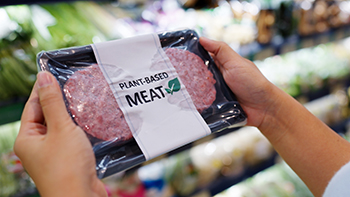By: Rick Stein, Vice President, Fresh Foods, FMI

A few years ago, several meat alternative companies made headlines with one small change—placing their products alongside traditional meat counterparts in the meat section. A debate ensued that continues today—where should plant-based foods and beverages be located in-store?
FMI’s Power of Plant-based Foods and Beverages 2022 report takes a broad, comprehensive review of the plant-based topic, exploring the landscape of naturally plant-based foods such as fruits, vegetables, beans and whole grains, along with alternatives to traditional animal-derived items. We asked shoppers three important questions about the location of plant-based products, and the answers just might surprise you.
1. Do shoppers know where to find certain plant-based products in-store?
When it comes to certain plant-based products, shoppers have a good sense of where to look in-store. For example, 75% of shoppers know to locate fruits and vegetables in the produce department and more than half report always knowing where to locate dairy milk alternatives and beans/peas/lentils.
However, when it comes to locating other plant-based products, shoppers’ confusion increases. Only 36% of shoppers know where to find different meat alternatives in-store and only 33% know where to find soy products. Consumer confusion is important to address because if a shopper can’t identify where a product is located in-store it leaves the possibility of product substitution or visiting another store to meet their needs.
2. Where in the store do shoppers want to find certain plant-based products?
Shopper have strong opinions about where they want to find plant-based products—particularly when it comes to the hot topic of meat alternatives. For meat alternatives with beans/vegetables/grains and meat alternatives with isolated protein/starch about half of shoppers want to find these products in a plant-based foods section of the store and the other half wants to find them in the frozen foods section. Lower on the lists of where shoppers wanted to find both types of meat alternative products were the meat and produce departments. Clearly the debate about meat alternative products is ongoing.

3. Which stores do consumers shop for plant-based products?
Most shoppers (49%) shop for plant-based products at their grocery store with mass stores coming in a close second place (45%). Interestingly, 47% of consumers shop for plant-based foods and beverages online. These shoppers indicate that shopping online for plant-based products has a slightly better buying experience because it allows them to engage in discovery, stick to budgets, easily find items and learn more about nutrition and ingredients. It’s important to consider the advantages online shopping for plant-based products offers and see if there is a way to translate those advantages to the in-store experience.


 Industry Topics address your specific area of expertise with resources, reports, events and more.
Industry Topics address your specific area of expertise with resources, reports, events and more.
 Our Research covers consumer behavior and retail operation benchmarks so you can make informed business decisions.
Our Research covers consumer behavior and retail operation benchmarks so you can make informed business decisions.
 Events and Education including online and in-person help you advance your food retail career.
Events and Education including online and in-person help you advance your food retail career.
 Food Safety training, resources and guidance that help you create a company food safety culture.
Food Safety training, resources and guidance that help you create a company food safety culture.
 Government Affairs work — federal and state — on the latest food industry policy, regulatory and legislative issues.
Government Affairs work — federal and state — on the latest food industry policy, regulatory and legislative issues.
 Get Involved. From industry awards to newsletters and committees, these resources help you take advantage of your membership.
Get Involved. From industry awards to newsletters and committees, these resources help you take advantage of your membership.
 Best practices, guidance documents, infographics, signage and more for the food industry on the COVID-19 pandemic.
Best practices, guidance documents, infographics, signage and more for the food industry on the COVID-19 pandemic.
